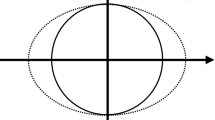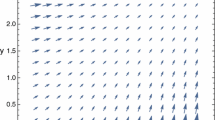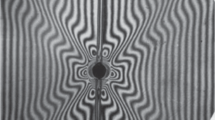Abstract
A theoretical description of electromagnetic waves in the background of a (weak) gravitational wave is presented. Explicit expressions are obtained for the Stokes parameters during the passage of a plane-fronted gravitational wave described by the Ehlers–Kundt metric. In particular, it is shown that the axis of the polarization ellipse oscillates, its ellipticity remaining constant.
Similar content being viewed by others
References
LIGO project. http://www.ligo.caltech.edu/
Ehlers, J., Kundt, W.: In: Witten, L. (ed.) The Theory of Gravitation, pp. 86–101. Wiley, New York (1962)
Misner, C.W., Thorne, K.S., Wheeler, J.A.: Gravitation. W. H. Freeman, San Francisco (1973)
Born, M., Wolf, E.: Principles of Optics, pp. 30–31. Pergamon Press, Oxford (1975)
Acknowledgments
Work supported in part by PAPIIT Project IN-101511 (DGAPA, UNAM).
Author information
Authors and Affiliations
Corresponding author
Appendix
Appendix
In this appendix, the EM field in the limit of flat space-time is worked out according to the formalism of the present paper. This permits to characterize the EM field before and during the passage of the gravitational wave and compare both cases. In flat space-time, the electric field is given by
where \(k^{\alpha } = ( \omega ,{\mathbf k})\) in Minkowski coordinates and \(S =k_{\alpha } x^{\alpha }\). It is important to notice that the gauge used in this paper is such that \(a_v =-a^u=0\), and therefore \(a^t = a^z\). Thus the condition \(k^{\alpha } a_{\alpha }=0\) implies
and of course \({\mathbf E} \cdot {\mathbf k} =0\).
The unit vectors \(\hat{\epsilon }_{\alpha }^{(i)}\) have purely space components:
and thus
Rights and permissions
About this article
Cite this article
Hacyan, S. Electromagnetic waves and Stokes parameters in the wake of a gravitational wave. Gen Relativ Gravit 44, 2923–2931 (2012). https://doi.org/10.1007/s10714-012-1434-4
Received:
Accepted:
Published:
Issue Date:
DOI: https://doi.org/10.1007/s10714-012-1434-4




